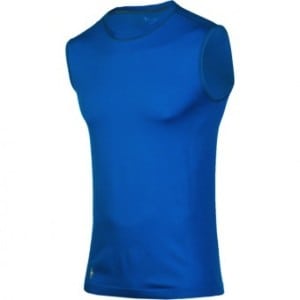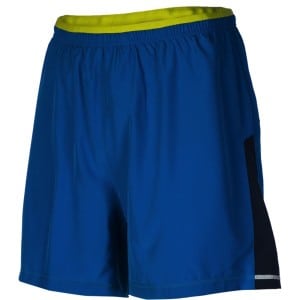I’ve been a fan of Merino wool clothing for several years now, mainly in the winter when the frigid mornings require my heaviest layers. But, as running apparel companies have managed to create thinner, warmer, and lighter clothing, I found my heavy, old Merino shirts relegated to casual wear. That was until I started testing Smartwool’s PhD run gear this past spring. Made of an extremely light and thin Merino wool blend, these items were versatile enough to wear in the heat of summer and worked incredibly well as lightweight baselayers. I take a look at a few of the items in the line below.
SmartWool PhD Run Zip T
 Made of 79% Merino wool and 21% nylon, the Run Zip T ended up being a daily garment this past spring when the morning temps hovered from 20 to 50 degrees Fahrenheit. Worn on its own, or underneath a shell, the thin yet somehow durable SmartWool PhD Run Zip T ($110) surprised me with the kind of daily abuse it could take. At one point, I wore this shirt every morning for two weeks in a row with only the occasional hand washing. The shirt maintained its shape well and didn’t stretch out with repeated washings. I’ve taken multiple diggers in the Run Zip T and there is not even a snag in the fabric.
Made of 79% Merino wool and 21% nylon, the Run Zip T ended up being a daily garment this past spring when the morning temps hovered from 20 to 50 degrees Fahrenheit. Worn on its own, or underneath a shell, the thin yet somehow durable SmartWool PhD Run Zip T ($110) surprised me with the kind of daily abuse it could take. At one point, I wore this shirt every morning for two weeks in a row with only the occasional hand washing. The shirt maintained its shape well and didn’t stretch out with repeated washings. I’ve taken multiple diggers in the Run Zip T and there is not even a snag in the fabric.
Due to the blended nature of the fabric, the PhD Run Zip T did not have the same fabled odor fighting protection which my full Merino shirts have. However, the breathability was worth the tradeoff and the thin nature of the fabric dried quickly after periods of intense sweating. The eight-inch zipper allowed additional ventilating and seamless construction around the armpits made for a chafe-free fit, even when soaked. The only drawback to this fabric blend happens when it is sweat saturated and the shirt tended to sag a bit which necessitated tucking it into my shorts to have the same close fitting comfort. It would hold shape when dry or partially damp, and the shirt airs out and dries very quickly.
SmartWool PhD Run Sleeveless Top
 This very simple sleeveless top also became a daily favorite over the past five months. Consisting of the same fabric blend (79% Merino, 21% nylon), the SmartWool Run Sleeveless Top ($80) combines a form fit with breathable panels and seamless construction which made it comfortable for hours on end. The soft nature of the fabric allowed me to wear this shirt for six-hour runs without bloody nips or chafing, and wearing the Run Sleeveless Top as a baselayer was especially effective underneath a light shell.
This very simple sleeveless top also became a daily favorite over the past five months. Consisting of the same fabric blend (79% Merino, 21% nylon), the SmartWool Run Sleeveless Top ($80) combines a form fit with breathable panels and seamless construction which made it comfortable for hours on end. The soft nature of the fabric allowed me to wear this shirt for six-hour runs without bloody nips or chafing, and wearing the Run Sleeveless Top as a baselayer was especially effective underneath a light shell.
From an aesthetic standpoint, the Run Sleeveless Top also was remarkably easy to keep clean and gel stains, coke, and a lot of blood (did I mention I fall a lot) came out in one wash. The same sagging problem occurred with the Sleeveless Top, but it didn’t bother me much because the shirt is so form fitting in the first place. At 5’10” and 145 pounds, the Run Sleeveless Top was form fitting in a size small, but loosened up perfectly once I started sweating a little.
SmartWool PhD Run Short
[For more of our current favorite running shorts, take a look at our best running shorts for men guide.]
 At first glance, the SmartWool PhD Run Short ($75) is underwhelming. A five-inch inseam and a simple zippered envelope packet in the back are fairly standard on shorts less than half this price. But, the Merino brief on the inside provides incredible comfort and support and it maintains its shape no matter how wet it gets. I’ve worn these shorts in rainstorms and the uber-comfortable brief stays in place and is chafe-free. I would compare the fit, which is a bit fuller and more supportive than most liners, to the Pearl Izumi Minerale brief only this one is made of Merino wool. The waistband is seamless and incredibly comfortable and the rest of the brief is seamless, as well. The PhD Run Short would be a great candidate for runners who struggle with chafe from the liners of their shorts, and the modest inseam, lack of a side split, and baggy comfort will appeal to modest trail runners who value comfort above all else.
At first glance, the SmartWool PhD Run Short ($75) is underwhelming. A five-inch inseam and a simple zippered envelope packet in the back are fairly standard on shorts less than half this price. But, the Merino brief on the inside provides incredible comfort and support and it maintains its shape no matter how wet it gets. I’ve worn these shorts in rainstorms and the uber-comfortable brief stays in place and is chafe-free. I would compare the fit, which is a bit fuller and more supportive than most liners, to the Pearl Izumi Minerale brief only this one is made of Merino wool. The waistband is seamless and incredibly comfortable and the rest of the brief is seamless, as well. The PhD Run Short would be a great candidate for runners who struggle with chafe from the liners of their shorts, and the modest inseam, lack of a side split, and baggy comfort will appeal to modest trail runners who value comfort above all else.
Overall Impressions
The Smartwool PhD Run line takes the temperature-regulating properties of Merino to the next level. Merino wool maintains warmth when wet better than any other fabric I’ve tried, and the thinness of the PhD apparel make it wearable all year round. The major downside of any Merino wool garment is that when wet it will retain its moisture for much longer than synthetic fibers. This can be a bonus as the moisture provides a cooling effect on the skin. I’ll be honest, it was a bit toasty wearing the Sleeveless Top in 85 degrees, but then again just about any shirt is. The durability of this line is undeniable and I have no doubts that I will be wearing these garments for years to come. I also washed and dried the PhD garments with the rest of my laundry without any ill effects.
I wanted evidence that the Merino wool manufacturing process was cleaner and less polluting than synthetic fibers. This Life Cycle Assessment Chart, produced by Nike, shows the different pollutant levels of various fabrics, and although wool is fairly efficient to process, its high expense cannot be avoided due to raising the sheep, etc… However, given the polluting manufacturing practices of polyester and polypropylene (primarily milled in Asia), it makes me feel good to wear the best fiber that nature can provide.
